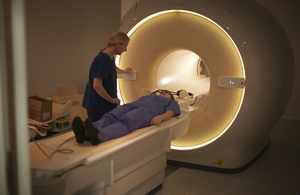Cancers are being diagnosed earlier in England
New PHE research shows the proportion of cancers diagnosed as a result of emergency presentation at hospital has decreased.

MRI scan in use, at UCL Hospital
The proportion of cancers diagnosed as a result of emergency presentation at hospital has decreased. At the same time, the proportion of cancers diagnosed through urgent GP referral with a suspicion of cancer (known as the two week wait) has increased.
Presented at the second day of the PHE Conference 2015, these results are taken from the updated Routes to Diagnosis data, covering patients diagnosed with cancer from 2006 to 2013, with 2011 to 2013 being published for the first time. These new preliminary figures show the proportion of patients diagnosed by route and by year in England.
In 2006 almost 25% of cancers, one in four, were diagnosed as an emergency. In 2013 this figure had fallen to 20%, or one in five. This is against a rise overall in the numbers of cases of cancer.
For a common cancer like lung, the proportion diagnosed through the GP two week wait referral route increased from 22% in 2006 to 28% in 2013, while the proportion diagnosed through emergency presentation fell each year, from 39% in 2006 down to 35% in 2013.
Julia Verne, Head of Clinical Epidemiology, Public Health England, said:
The latest Routes to Diagnosis data shows a positive trend in how cancer is diagnosed in England. The earlier the better if we are to catch up with comparable European countries and I am pleased that our Routes to Diagnosis work has been able to drive this. We should also note the importance of other work like PHE’s Be Clear on Cancer campaigns in helping people spot symptoms early and PHE’s NHS Screening Programmes in helping detect some cancers early.
The reason this is good news is because patients diagnosed as an emergency presentation have lower chances of survival compared to those diagnosed in other routes.
“These improvements in routes to cancer diagnosis follow several years of work across the sector to improve early diagnosis in England. Our work however, is not complete; while emergency presentation is declining it still remains high for cancers like liver and pancreas.
Sara Hiom, director of early diagnosis at Cancer Research UK, said:
It’s really encouraging to see fewer people being diagnosed through emergency routes, because we know survival is poorer and the experience is worse for these patients. When cancer is caught early, we have more options for treatments and a far better chance of beating the disease.
But we must still do better. It’s unacceptable to see such variation in patient care continuing, and too many people are still being diagnosed as an emergency in hospital. As well as variation by cancer type and between hospitals, there are also significant differences in the treatment of our older patients, such as being much less likely to have surgery than younger ones. The new cancer strategy makes clear recommendations for how we can improve England’s cancer survival and patients’ experience. There should be no reason why we can’t be as good as the best in the world.
Ends
Background
The report Routes to Diagnosis 2006-2013, preliminary results has been published on the NCIN website, with the full data to follow shortly: http://www.ncin.org.uk/publications/routes_to_diagnosis
Compared to the European average, cancer survival in England is low. Studies have suggested this difference could be largely due to later diagnosis, by which time cancers are harder to treat and have progressed to a more advanced stage.
This fact led to the development of the National Awareness and Early Diagnosis Initiative (NAEDI). One key piece of this work is the Routes to Diagnosis data, the preliminary results of which are launched today.
The National Cancer Intelligence Network in PHE has worked with (partners) Cancer Research UK on the Routes to Diagnosis project since 2007 and it has greatly improved the understanding of where delays arise. NCIN both defined a methodology to determine the route a patient took through the healthcare system before receiving a cancer diagnosis and collects and analyses the data on it.
The Routes to Diagnosis methodology is described in the report.
A Route to Diagnosis describes the end point of the pathway a patient follows to a diagnosis of cancer. There are eight aggregated Routes derived from multiple linked data sets. These include Two Week Wait (urgent GP referral with a suspicion of cancer) and Emergency Presentation (an emergency Route via A&E, emergency GP referral, emergency transfer, emergency consultant outpatient referral or emergency admission or attendance).
The National Cancer Intelligence Network (NCIN) is part of Public Health England.
PHE has run several Be Clear on Cancer campaigns for different cancer sites: http://www.nhs.uk/be-clear-on-cancer
For bids please contact Dominic Stanley or Dawn Tennant at Public Health England: phe-pressoffice@phe.gov.uk telephone 020 7654 8400, out of hours telephone 020 8200 4400.
Public Health England exists to protect and improve the nation’s health and wellbeing, and reduce health inequalities. It does this through world-class science, knowledge and intelligence, advocacy, partnerships and the delivery of specialist public health services. PHE is an operationally autonomous executive agency of the Department of Health. Website: www.gov.uk/phe. Twitter: @PHE_uk, Facebook: www.facebook.com/PublicHealthEngland.
UK Health Security Agency press office
10 South Colonnade
London
E14 4PU